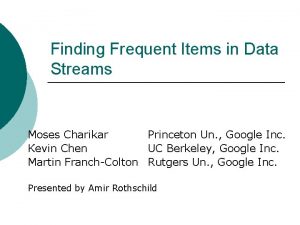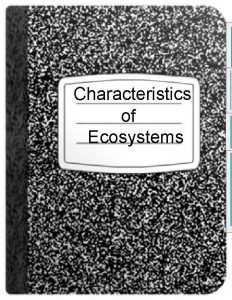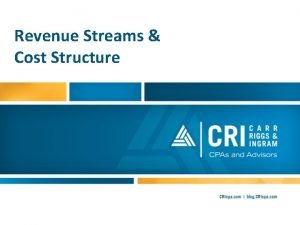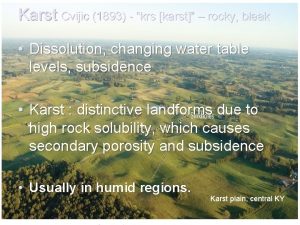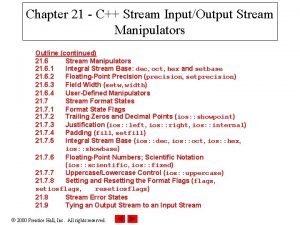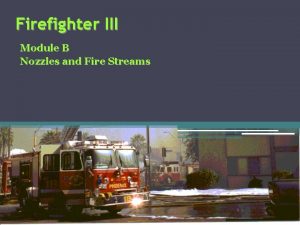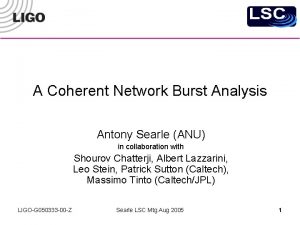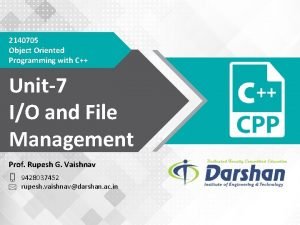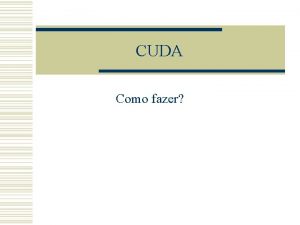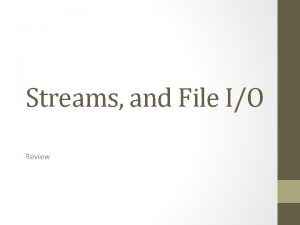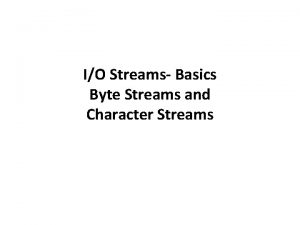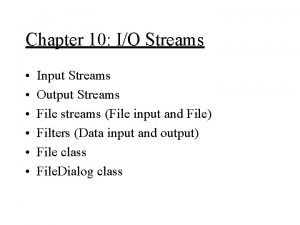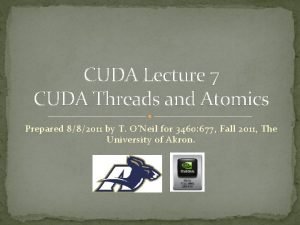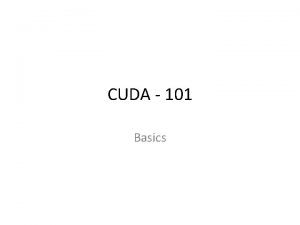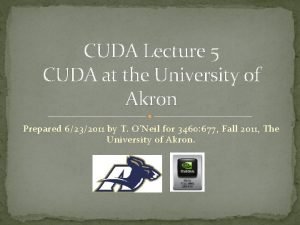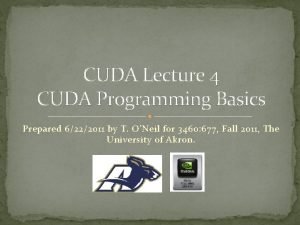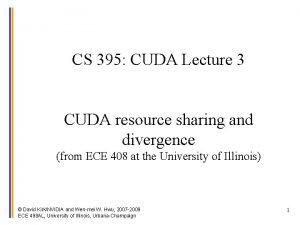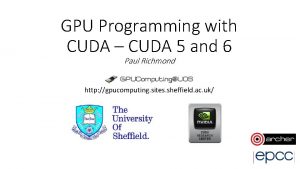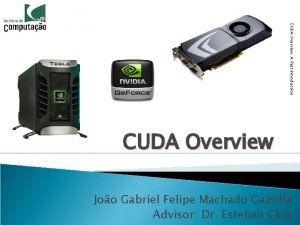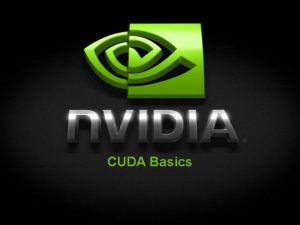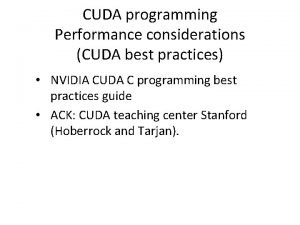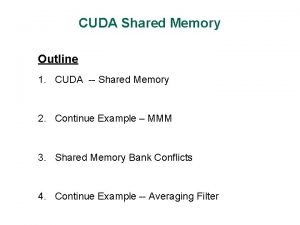Lecture 11 Data Transfer and CUDA Streams David



















- Slides: 19

Lecture 11: Data Transfer and CUDA Streams © David Kirk/NVIDIA and Wen-mei W. Hwu, 2007 -2012 ECE 408/CS 483, ECE 498 AL, University of Illinois, Urbana-Champaign

Objective • To learn more advanced features of the CUDA APIs for data transfer and kernel launch – Task parallelism for overlapping data transfer with kernel computation – CUDA streams © David Kirk/NVIDIA and Wen-mei W. Hwu, 2007 -2012 ECE 408/CS 483, ECE 498 AL, University of Illinois, Urbana-Champaign

Serialized Data Transfer and GPU computation • So far, the way we use cuda. Memcpy serializes data transfer and GPU computation Trans. A Trans. B Vector Add Tranfer C time Only use one direction, GPU idle PCIe Idle © David Kirk/NVIDIA and Wen-mei W. Hwu, 2007 -2012 ECE 408/CS 483, ECE 498 AL, University of Illinois, Urbana-Champaign Only use one direction, GPU idle

Device Overlap • Some CUDA devices support device overlap – Simultaneously execute a kernel while performing a copy between device and host memory int dev_count; cuda. Device. Prop prop; cuda. Get. Device. Count( &dev_count); for (int i = 0; i < dev_count; i++) { cuda. Get. Device. Properties(&prop, i); if (prop. device. Overlap) … © David Kirk/NVIDIA and Wen-mei W. Hwu, 2007 -2012 ECE 408/CS 483, ECE 498 AL, University of Illinois, Urbana-Champaign

Overlapped (Pipelined) Timing • Divide large vectors into segments • Overlap transfer and compute of adjacent segments Trans A. 1 Trans B. 1 Comp Trans C. 1 = A. 1 + B. 1 C. 1 Trans A. 2 Trans B. 2 Comp Trans C. 2 = A. 2 + B. 2 C. 2 Trans A. 3 © David Kirk/NVIDIA and Wen-mei W. Hwu, 2007 -2012 ECE 408/CS 483, ECE 498 AL, University of Illinois, Urbana-Champaign Trans B. 3 Comp C. 3 = A. 3 + B. 3 Trans A. 4 Trans B. 4

Using CUDA Streams and Asynchronous Mem. Cpy • CUDA supports parallel execution of kernels and cuda. Memcpy with “Streams” • Each stream is a queue of operations (kernel launches and cuda. Memcpy’s) • Operations (tasks) in different streams can go in parallel – “Task parallelism” © David Kirk/NVIDIA and Wen-mei W. Hwu, 2007 -2012 ECE 408/CS 483, ECE 498 AL, University of Illinois, Urbana-Champaign

Streams • Device requests made from the host code are put into a queue – Queue is read and processed asynchronously by the driver and device – Driver ensures that commands in the queue are processed in sequence. Memory copies end before kernel launch, etc. host thread cuda. Memcpy Kernel launch sync fifo device driver © David Kirk/NVIDIA and Wen-mei W. Hwu, 2007 -2012 ECE 408/CS 483, ECE 498 AL, University of Illinois, Urbana-Champaign 7

Streams cont. • To allow concurrent copying and kernel execution, you need to use multiple queues, called “streams” host thread Stream 1 Stream 2 Event – CUDA “events” allow the host thread to query and synchronize with the individual queues. device driver © David Kirk/NVIDIA and Wen-mei W. Hwu, 2007 -2012 ECE 408/CS 483, ECE 498 AL, University of Illinois, Urbana-Champaign 8

Conceptual View of Streams PCIe UP PCIe Down Copy Engine Kernel Engine Mem. Cpy A. 1 Mem. Cpy A. 2 Mem. Cpy B. 1 Mem. Cpy B. 2 Kernel 1 Kernel 2 Mem. Cpy C. 1 Stream 0 Mem. Cpy C. 2 Stream 1 Operations (Kernels, Mem. Cpys) © David Kirk/NVIDIA and Wen-mei W. Hwu, 2007 -2012 ECE 408/CS 483, ECE 498 AL, University of Illinois, Urbana-Champaign

A Simple Multi-Stream Host Code cuda. Stream_t stream 0, stream 1; cuda. Stream. Create( &stream 0); cuda. Stream. Create( &stream 1); float *d_A 0, *d_B 0, *d_C 0; // device memory for stream 0 float *d_A 1, *d_B 1, *d_C 1; // device memory for stream 1 // cuda. Malloc for d_A 0, d_B 0, d_C 0, d_A 1, d_B 1, d_C 1 go here for (int i=0; i<n; i+=Seg. Size*2) { cuda. Mem. Cpy. Async(d_A 0, h_A+i; Seg. Size*sizeof(float), . . , stream 0); cuda. Mem. Cpy. Async(d_B 0, h_B+i; Seg. Size*sizeof(float), . . , stream 0); vec. Add<<<Seg. Size/256, 0, stream 0); cuda. Mem. Cpy. Async(d_C 0, h_C+i; Seg. Size*sizeof(float), . . , stream 0); © David Kirk/NVIDIA and Wen-mei W. Hwu, 2007 -2012 ECE 408/CS 483, ECE 498 AL, University of Illinois, Urbana-Champaign

A Simple Multi-Stream Host Code (Cont. ) for (int i=0; i<n; i+=Seg. Size*2) { cuda. Mem. Cpy. Async(d_A 0, h_A+i; Seg. Size*sizeof(float), . . , stream 0); cuda. Mem. Cpy. Async(d_B 0, h_B+i; Seg. Size*sizeof(float), . . , stream 0); vec. Add<<<Seg. Size/256, 0, stream 0)(d_A 0, d_B 0, …); cuda. Mem. Cpy. Async(d_C 0, h_C+i; Seg. Size*sizeof(float), . . , stream 0); cuda. Mem. Cpy. Async(d_A 1, h_A+i+Seg. Size; Seg. Size*sizeof(float), . . , stream 1); cuda. Mem. Cpy. Async(d_B 1, h_B+i+Seg. Size; Seg. Size*sizeof(float), . . , stream 1); vec. Add<<<Seg. Size/256, 0, stream 1>>>(d_A 1, d_B 1, …); cuda. Mem. Cpy. Async(d_C 1, h_C+i+Seg. Size; Seg. Size*sizeof(float), . . , stream 1); © David Kirk/NVIDIA and Wen-mei W. Hwu, 2007 -2012 } ECE 408/CS 483, ECE 498 AL, University of Illinois, Urbana-Champaign

A View Closer to Reality PCI UP PCI Down Copy Engine Kernel Engine Mem. Cpy A. 1 Kernel 1 Mem. Cpy B. 1 Kernel 2 Mem. Cpy C. 1 Mem. Cpy A. 2 Mem. Cpy B. 2 Mem. Cpy C. 2 Stream 0 Stream 1 Operations (Kernels, Mem. Cpys) © David Kirk/NVIDIA and Wen-mei W. Hwu, 2007 -2012 ECE 408/CS 483, ECE 498 AL, University of Illinois, Urbana-Champaign

Another Multi-Stream Host Code (Cont. ) for (int i=0; i<n; i+=Seg. Size*2) { cuda. Mem. Cpy. Async(d_A 0, h_A+i; Seg. Size*sizeof(float), . . , stream 0); cuda. Mem. Cpy. Async(d_B 0, h_B+i; Seg. Size*sizeof(float), . . , stream 0); cuda. Mem. Cpy. Async(d_A 1, h_A+i+Seg. Size; Seg. Size*sizeof(float), . . , stream 1); cuda. Mem. Cpy. Async(d_B 1, h_B+i+Seg. Size; Seg. Size*sizeof(float), . . , stream 1); vec. Add<<<Seg. Size/256, 0, stream 0)(d_A 0, d_B 0, …); vec. Add<<<Seg. Size/256, 0, stream 1>>>(d_A 1, d_B 1, …); cuda. Mem. Cpy. Async(d_C 0, h_C+I; Seg. Size*sizeof(float), . . , stream 0); cuda. Mem. Cpy. Async(d_C 1, h_C+i+Seg. Size; Seg. Size*sizeof(float), . . , stream 1); © David Kirk/NVIDIA and Wen-mei W. Hwu, 2007 -2012 } ECE 408/CS 483, ECE 498 AL, University of Illinois, Urbana-Champaign

A View Closer to Reality PCI UP PCI Down Copy Engine Kernel Engine Mem. Cpy A. 1 Kernel 1 Mem. Cpy B. 1 Kernel 2 Mem. Cpy A. 2 Mem. Cpy B. 2 Mem. Cpy C. 1 Mem. Cpy C. 2 Stream 0 Stream 1 Operations (Kernels, Mem. Cpys) © David Kirk/NVIDIA and Wen-mei W. Hwu, 2007 -2012 ECE 408/CS 483, ECE 498 AL, University of Illinois, Urbana-Champaign

Overlapped (Pipelined) Timing • Divide large vectors into segments • Overlap transfer and compute of adjacent segments Trans A. 1 Trans B. 1 Comp Trans C. 1 = A. 1 + B. 1 C. 1 Trans A. 2 Trans B. 2 Comp Trans C. 2 = A. 2 + B. 2 C. 2 Trans A. 3 © David Kirk/NVIDIA and Wen-mei W. Hwu, 2007 -2012 ECE 408/CS 483, ECE 498 AL, University of Illinois, Urbana-Champaign Trans B. 3 Comp C. 3 = A. 3 + B. 3 Trans A. 4 Trans B. 4

Hyper Queue • Provide multiple real queues for each engine • Allow much more concurrency by allowing some streams to make progress for an engine while others are blocked © David Kirk/NVIDIA and Wen-mei W. Hwu, 2007 -2012 ECE 408/CS 483, ECE 498 AL, University of Illinois, Urbana-Champaign

Fermi (and older) Concurrency A -- B -- C Stream 1 A--B--C P--Q--R X--Y--Z P -- Q -- R Stream 2 Hardware Work Queue X -- Y -- Z Stream 3 Fermi allows 16 -way concurrency – Up to 16 grids can run at once – But CUDA streams multiplex into a single queue – Overlap only at stream edges © David Kirk/NVIDIA and Wen-mei W. Hwu, 2007 -2012 ECE 408/CS 483, ECE 498 AL, University of Illinois, Urbana-Champaign

Kepler Improved Concurrency A--B--C A -- B -- C Stream 1 P--Q--R P -- Q -- R Stream 2 X--Y--Z X -- Y -- Z Multiple Hardware Work Queues Stream 3 Kepler allows 32 -way concurrency One work queue per stream Concurrency at full-stream level No inter-stream dependencies © David Kirk/NVIDIA and Wen-mei W. Hwu, 2007 -2012 ECE 408/CS 483, ECE 498 AL, University of Illinois, Urbana-Champaign

ANY QUESTIONS? © David Kirk/NVIDIA and Wen-mei W. Hwu, 2007 -2012 ECE 408/CS 483, ECE 498 AL, University of Illinois, Urbana-Champaign
 Data nugget streams as sensors answers
Data nugget streams as sensors answers Basic concepts in mining data streams
Basic concepts in mining data streams A framework for clustering evolving data streams
A framework for clustering evolving data streams Finding frequent items in data streams
Finding frequent items in data streams 01:640:244 lecture notes - lecture 15: plat, idah, farad
01:640:244 lecture notes - lecture 15: plat, idah, farad Characteristics of wetlands
Characteristics of wetlands Yakshi holding a fly whisk
Yakshi holding a fly whisk Streams and rivers abiotic factors
Streams and rivers abiotic factors Is a disturbance that transfers energy
Is a disturbance that transfers energy Types of jet streams
Types of jet streams Cost streams
Cost streams Streams aq: waiting for messages in the queue
Streams aq: waiting for messages in the queue Poljes
Poljes In the desert, ephemeral streams _____.
In the desert, ephemeral streams _____. Parameterized stream manipulator
Parameterized stream manipulator Physical states
Physical states Illustrate the proper handling of fire streams
Illustrate the proper handling of fire streams Oracle streams
Oracle streams Streams anu
Streams anu Concept of streams
Concept of streams



